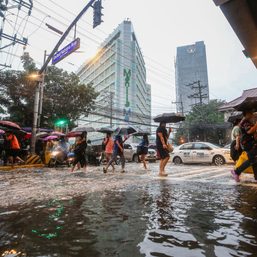SUMMARY
This is AI generated summarization, which may have errors. For context, always refer to the full article.
![[In This Economy] El Niño-nomics: How intense heat is drying up the Philippine economy](https://www.rappler.com/tachyon/2024/05/TL-El-nino-nomics-May-3-2024.jpg)
Many studies have already said that the Philippines is among the countries most at risk (if not the most at risk) from climate change.
So it should not be surprising that we experienced extreme, debilitating heat in this year’s El Niño.
On April 28, the heat index at Iba, Zambales reached a scorching 53 degrees Celsius – already within “extreme danger” levels that could cause heat strokes. Other parts of the country were not spared: temperatures reached 49 degrees in Camarines Sur, and 47 degrees in Nueva Ecija, Olongapo City, and Pangasinan.
Meanwhile, Metro Manila reached a historical high of 45 degrees Celsius.
It’s plain to see how extreme heat can dry up our economy. Going to work or class is quite difficult to do without melting while commuting. Even in the office or in class, it’s hard to concentrate unless you have the aircon on full blast. Heat-related illnesses also become more prevalent.
This 2024, we’ve tried to cope as much as we could. Some government offices shifted to a four-day work week. The government also advised private businesses to adopt “flexible working arrangements” (basically work from home). In-person classes have been suspended all over the country. (At UP, I’ve also shifted back to Zoom classes since April 11.)
But with climate change projected to get even worse, expect even more extreme El Niños (and La Niñas, for that matter) in the coming decades.
Macro impact
Economic studies of climate change have established solid evidence on the link between extreme temperatures and economic activity: through lower productivity, lower output, lower investments, etc.
Just this year, some economists at the Bangko Sentral ng Pilipinas (BSP) came up with a study quantifying the impact of heat increases on Philippine economic data like GDP (gross domestic product) growth and inflation. You can check out the entire paper here.
They found that a one-degree Celsius increase of annual mean temperature reduces GDP growth by 0.37 percentage point. That is statistically significant: you can rule out that it’s because of chance. And the effect rises to 0.47 percentage point if you take into account El Niño events.
Even more interesting is how that relationship arises. The same paper showed that extreme heat can bring down output in many sectors, most obviously agriculture (especially palay and corn production, but not mango production which supposedly likes the extra heat). Manufacturing production also goes down with heat, as well as services production (but to a lesser degree).
Curiously, they find that labor productivity doesn’t dip for sectors like construction, transportation, and manufacturing. So the drop in manufacturing output must be coming from some other factor.
Likely because of the drop in agricultural output, inflation also increases with average temperatures. Specifically, a one-degree Celsius increase of temperatures increases headline (or overall) inflation by 0.77 percentage point, an effect that could last as much as four years before dissipating! The effect is larger for inflation of food items, in particular.
This is an important result that could impact the way the BSP does monetary policy. You will recall that because of high inflation in 2022 and 2023, the BSP had to raise interest rates to discourage people from borrowing and spending. Now that inflation has abated, people are eagerly expecting the BSP to finally lower interest rates.
But with the sizzling temperatures in 2024’s El Niño months, the BSP expects inflation to rise again (even by a bit). Therefore, they will likely maintain high interest rates across the economy, and refuse to bring them down any time soon.
Since high interest rates tend to have a chokehold on the economy (precisely because they discourage borrowing and spending), we might have to endure slower-than-usual growth for a bit longer.
Our future productivity is also at risk. For example, if too many students are getting sick because of the heat, and can’t study well because of all the new class suspensions, their learning may be held back and their prospects later in life could suffer (in the form of, say, poorer job opportunities and lower wages and salaries).
This calls to mind the extremely long class closures during the pandemic, which resulted in tremendous “learning losses” which we’re still recovering from to this day.
Ill-prepared
As far back as March 2023, the Philippine Atmospheric, Geophysical and Astronomical Services Administration (PAGASA) already warned about El Niño.
But as I wrote in a previous piece, it was not until January 19, 2024 that Marcos signed an executive order reviving an Arroyo-era task force supposed to coordinate government preparations for El Niño. The truth is, Marcos sat on this year’s El Niño.
A much more competent leadership would’ve heeded PAGASA’s advanced warnings and taken action well before the intense heat arrived. But we may be asking too much from the present Marcos administration.
(To be fair, President Marcos did call on officials to prepare back in April 2023. But many sectors of our economy, and even government offices, were still caught unawares. Why?)
In May, we may be getting some reprieve: El Niño is winding down, and rain is set to come back. But that doesn’t mean our troubles are over.
Data from the US shows that we will likely transition from El Niño to La Nina in the next few months (see graph below). Starting March this year, PAGASA already started publishing its La Niña Watch.

Source: “April 2024 ENSO update: gone fishing,” published April 11, 2024. Link: climate.gov.
The question is: will the Marcos administration prepare better this time? Or is it up to Filipinos to again watch out for themselves? – Rappler.com
JC Punongbayan, PhD is an assistant professor at the UP School of Economics and the author of False Nostalgia: The Marcos “Golden Age” Myths and How to Debunk Them. He was recently named one of The Outstanding Young Men (TOYM) for 2023. JC’s views are independent of his affiliations. Follow him on Twitter/X (@jcpunongbayan) and Usapang Econ Podcast.
Add a comment
How does this make you feel?














![[EDITORIAL] Apat na taon na lang Ginoong Marcos, ‘di na puwede ang papetiks-petiks](https://www.rappler.com/tachyon/2024/07/animated-bongbong-marcos-2024-sona-day-carousel.jpg?resize=257%2C257&crop=280px%2C0px%2C720px%2C720px)
![[In This Economy] Delulunomics: Kailan magiging upper-middle income country ang Pilipinas?](https://www.rappler.com/tachyon/2024/07/in-this-economy-upper-middle-income-country.jpg?resize=257%2C257&crop=421px%2C0px%2C1080px%2C1080px)

![[EDITORIAL] Marcos Year 2: Hilong-talilong](https://www.rappler.com/tachyon/2024/07/animated-bongbong-marcos-2nd-sona-carousel.jpg?resize=257%2C257&crop=136px%2C0px%2C720px%2C720px)
![[Newspoint] A fighting presence](https://www.rappler.com/tachyon/2024/07/thought-leaders-a-fighting-presence.jpg?resize=257%2C257&crop=441px%2C0px%2C1080px%2C1080px)
There are no comments yet. Add your comment to start the conversation.